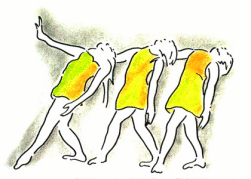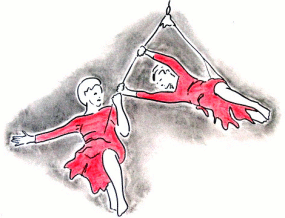Serendip is an independent site partnering with faculty at multiple colleges and universities around the world. Happy exploring!
Notes Towards (the first 1/2 of) Day 25: What We Have Learned....
What we've learned,
and where we might go next....
This is the fourth instantiation of this course.
In earlier versions,
Moby-Dick gave rise to Ahab's Wife;
Herculine Barbin to Middlesex;
Howard's End to On Beauty.
In each case, we relied heavily on
the contemporary authors
(Sena Naslund, Jeffrey Eugenides, Zadie Smith)
saying, explicitly, that they were
re-writing an earlier text.
In an author's note at the end of On Beauty,
Zadie Smith writes: "My largest structural debt
should be obvious to any E.M. Forster fan;
suffice it to say he gave me a classy old frame,
which I covered with new material as best I could."
That way of selection now seems to me,
retrospectively (how I have evolved!)
very timid, not very imaginative, and
It didn't allow for complexity,
or for unpredictability,
or for the "blooming, buzzing confusion"
out of which new texts arise.
too safe.
This year's selections were not
(Hustvedt, for starters, never named
Whitman as her literary grandfather...)
This was a much riskier experiment,
with many more variables.
whether our experiment "worked":
Sarah: what is definitely unclear to me is how this novel is more significant than any other recent novel
Elizabeth: “why this book?, isn’t there a better example out there?”
raising in this course is
what our standards are--for
seriousness, significance,
goodness, importance....
Are those the most useful standards,
for our learning?
Rica: there is no one best, final text for the course...we can be given almost any book and we will be able to interpret it as evolutionary fiction.
In other words, there might be other ways,
than the conventional ones,
to think about the relations among texts.
One of the things we have
used Hustvedt to model for us
(& any one of 100 other contemporary
stories might have done this)
is the ability of the conscious mind to
reflect on its unconscious processes.
The guiding idea here was that
Whitman used a new poetic form
to represent the unconscious,
largely unmediated (?).
The "turn" Hustvedt represented,
in the evolution of stories we are tracing,
was the ability of consciousness not only to
represent the unconscious @ work,
but to use its awareness to
change how we work.
We've had some good conversation about
how much change actually takes place in the novel,
whether the "stuckness" of the characters suggests
it's not the best example of "evolutionary fiction."
IOW, it's evolutionary precisely
because there's no sharp change (?).
But there is change.
We can learn to use our brains differently.
"diverges" and "converges."
So do our brains, which
think both "linearly" and "associatively,"
"convergently" and "divergently":
| |
Lucy Jo Palladino, The Edison Trait: Saving the Spirit of Your Free-Thinking Child in a Conforming World (1997)
- Facts alone matter.
- Measurements are quantitative.
- Thinking is analytic.
- "The convergent thinker perceives discreet units of thought....
she lives in a universe composed of atoms."
Enter "ADD"-->
- "The divergent thinker lives in a natural state of "brainstorm."
She sees life through a kaleidoscope that is set in perpetual motion.
- Patterns change frequently.
- Experience is described, not measured.
- Thoughts are multicolored, multishaped,
and hard to hold in one place.
- "The divergent thinker whirls with ideas and images.
She lives in a universe made up of stories."
Hustvedt's novel is an account of
this complexly-thinking mind,
diverging, converging, diverging again,
in on-going conversation with itself--
and with the history of (most of
the genres of!) fiction-writing.
to invite you to think of the future,
where you might go,
beyond where we have taken you.
The teacher's failings in which the students ripen...."
(Lewis Hyde, "This Error is the Sign of Love")
Here are some gestures in that direction:

(see the red drapes?) of
re-made, multipl-y, and dream-like,
from Miranda's perspective:
"In titling his play "The Tempest," Shakespeare opened its theme to a multitude of metaphors....Ours is all of these..complicated by the most perplexing tempest of all--the tempest of growing up. In focusing our production on Miranda's experience...Miranda inhabits all voices, taking on and exploring the opportunities granted to her in playing the role of the other characters....each of these subplots allows Miranda a chance to gain a better understanding of the world in which she lives, which in turn gives her the tools necessary to undertake the storminess of real life....working through a directorial and dramaturgical "brain trust," Miranda's journey has been influenced by more than one mind...[with all cast members] bringing to the table their own experiences of growing up...
The production seemed both the dream
out of which Shakespeare's play first arose, and
an evocation of the dreams to which it might give rise....
unconscious underlying/arising from classic texts
(Lord's production of The Tempest).
It might mean turning scientific texts into poetic ones
(Darwin's great-great-granddaughter):
“Nature is prodigal with time. She scrutinizes every muscle,
vessel, nerve. Every habit, instinct, shade
of constitution. There will be no caprice, no favouring...."
He does believe in a Divine Creator still
but not hers, not wise and kind. A ruthless shadowy thing
eternally going in for cruelty, elimination, waste.
unconscious underlying/arising from classic texts,
turning scientific texts into poetic ones,
or turning them into dance.

Four research papers transformed into modern dance-->
The Science Dance Match-Up Challenge
(can you turn 'em back into science?
why might it be important to do so?)

biological/cultural/individual evolution
refusing the conventional
"species" of course-construction:
mixing not just consciousness and the unconscious,
not just biology and poetry,
or biology and dance,
but crossing other modes:
juxtaposing different languages, different forms,
different art and....body-art?
Hello, Van Gogh, Can You Hear Me Now?
map its "post-evolutionary strategies....
The ear visualizes that idea that we can now engineer additional organs, Internet-enabled, to better function in the technological terrain that we now inhabit....
The doctors...were overheard discussing...that perhaps they were really the artists and my body was just the canvas!"

Freeman Dyson, "The Darwinian Interlude," in "The Future of Evolution" (Metanexus Institute, The Global Spiral), on the need for a new synthetic biology based on communities and eco-systems rather than on genes and molecules...
Now, after three billion years,
the Darwinian interlude is over. It was an interlude between two
periods of horizontal gene transfer. The epoch of Darwinian evolution
based on competition between species ended about ten thousand years ago
when a single species, Homo Sapiens, began to dominate and reorganize
the biosphere. Since that time, cultural evolution has replaced
biological evolution as the main driving force of change....Cultures spread by horizontal transfer of ideas more than by genetic
inheritance. Cultural evolution is running a thousand times faster than
Darwinian evolution, taking us into a new era of cultural
interdependence which we call globalization. And now, in the last
thirty years, Homo Sapiens has revived the ancient pre-Darwinian
practice of horizontal gene transfer, moving genes easily from microbes
to plants and animals, blurring the boundaries between species. We are
moving rapidly into the post-Darwinian era, when species will no longer
exist, and the evolution of life will again be communal. If you like,
you can call that the evolution of a noosphere.
Noosphere: the
"sphere of human thought," third in a succession of phases of
development of the Earth, after the geosphere (inanimate matter) and
the biosphere (biological life).
In such a world, what might happen to conventional plots,
as technology erases the boundaries between us?
If Only Literature Could Be a Cellphone-Free Zone
“We want a world where there’s distance between people;
that’s where great storytelling comes from."
"if Joseph has an iPhone, there’s no Judaism”
M. J. Rose intends to set her next book in 1948 in part so she can let missed connections and miscommunications simmer....
there will always be boundaries,
not just between us, but within:
we do not (yet? nor will ever?)
fully know ourselves.
And it is that boundedness which
provokes both the attempt to know, and
the storytelling about the attempt.
What do you think?


